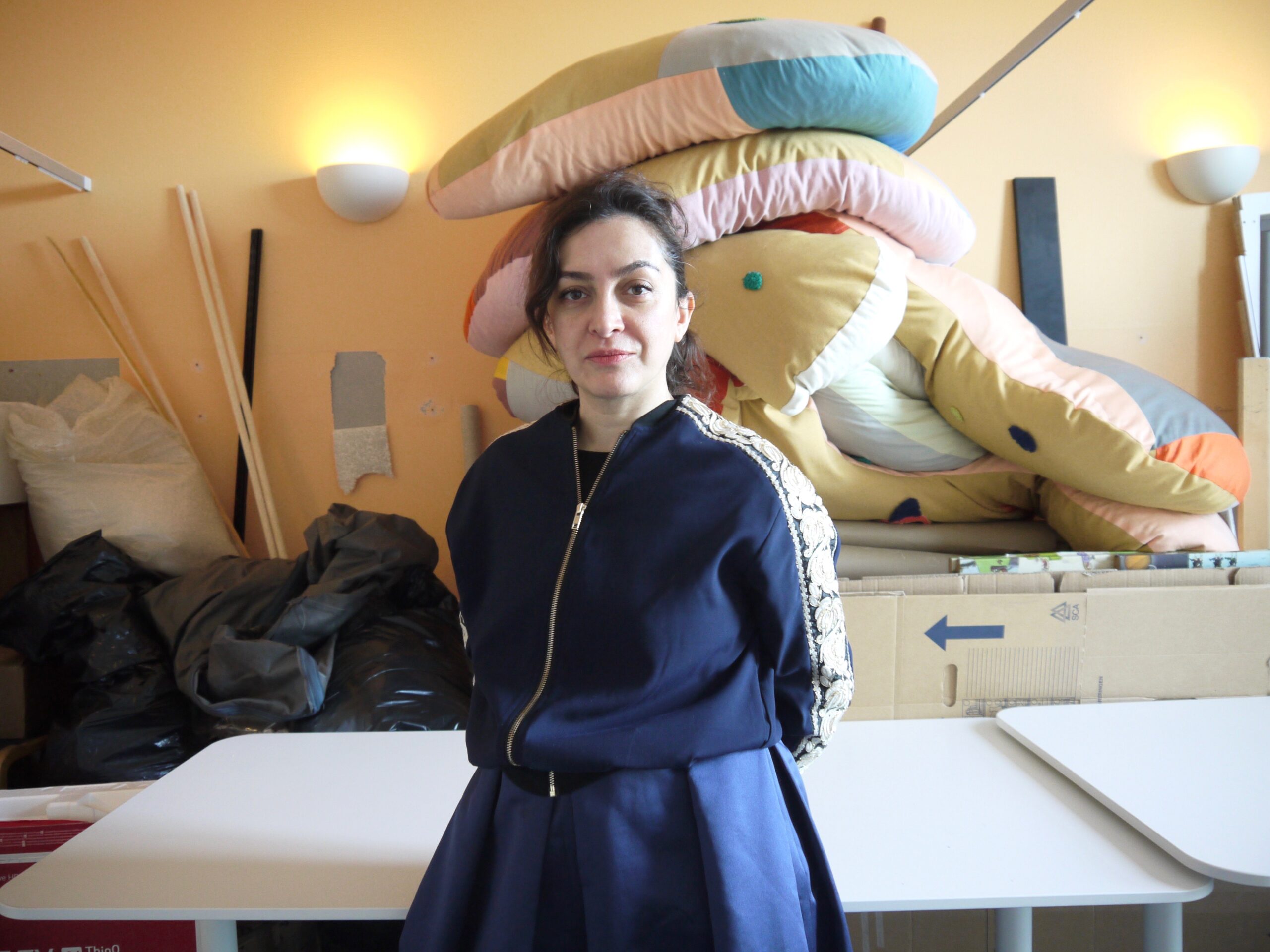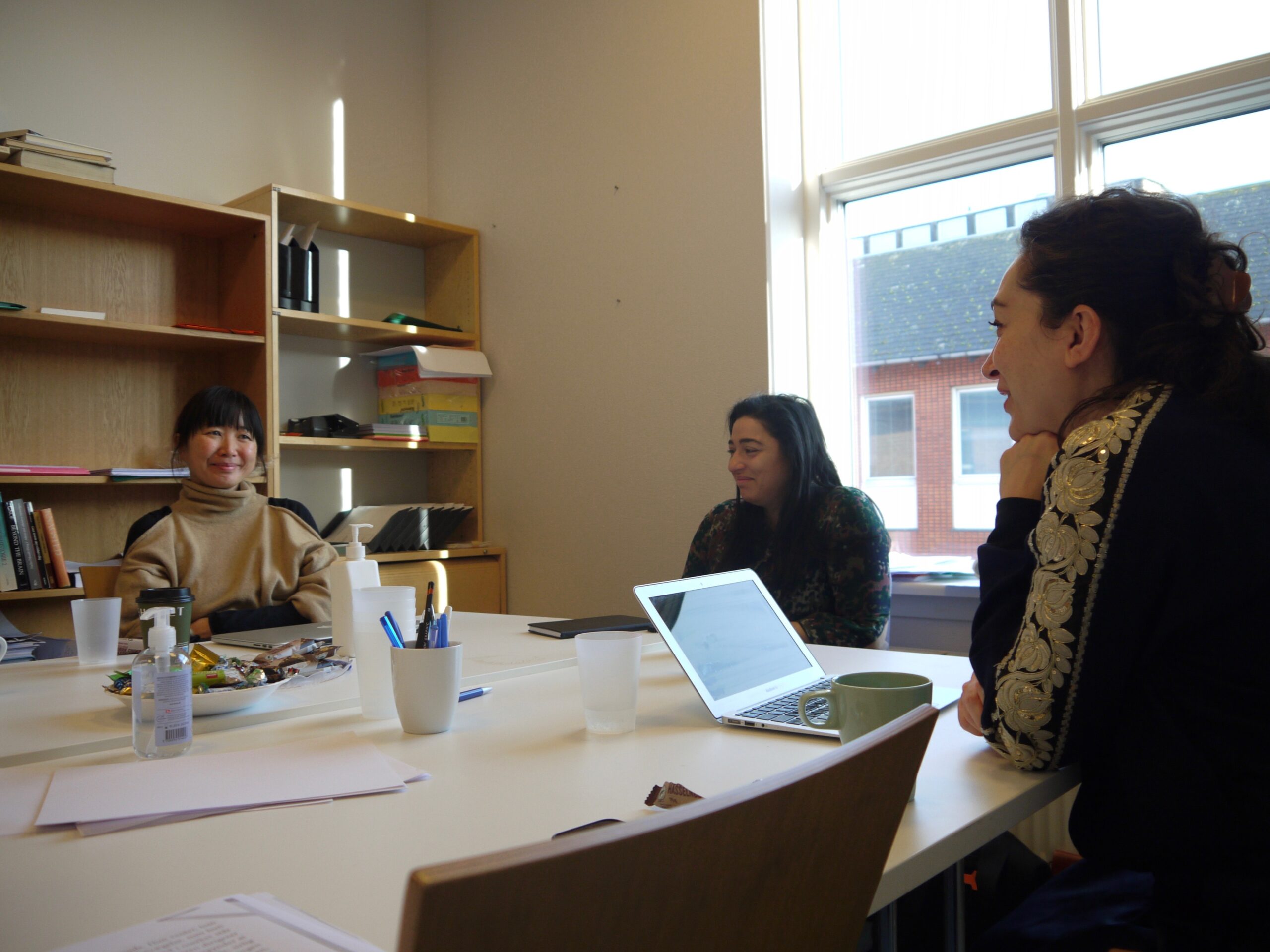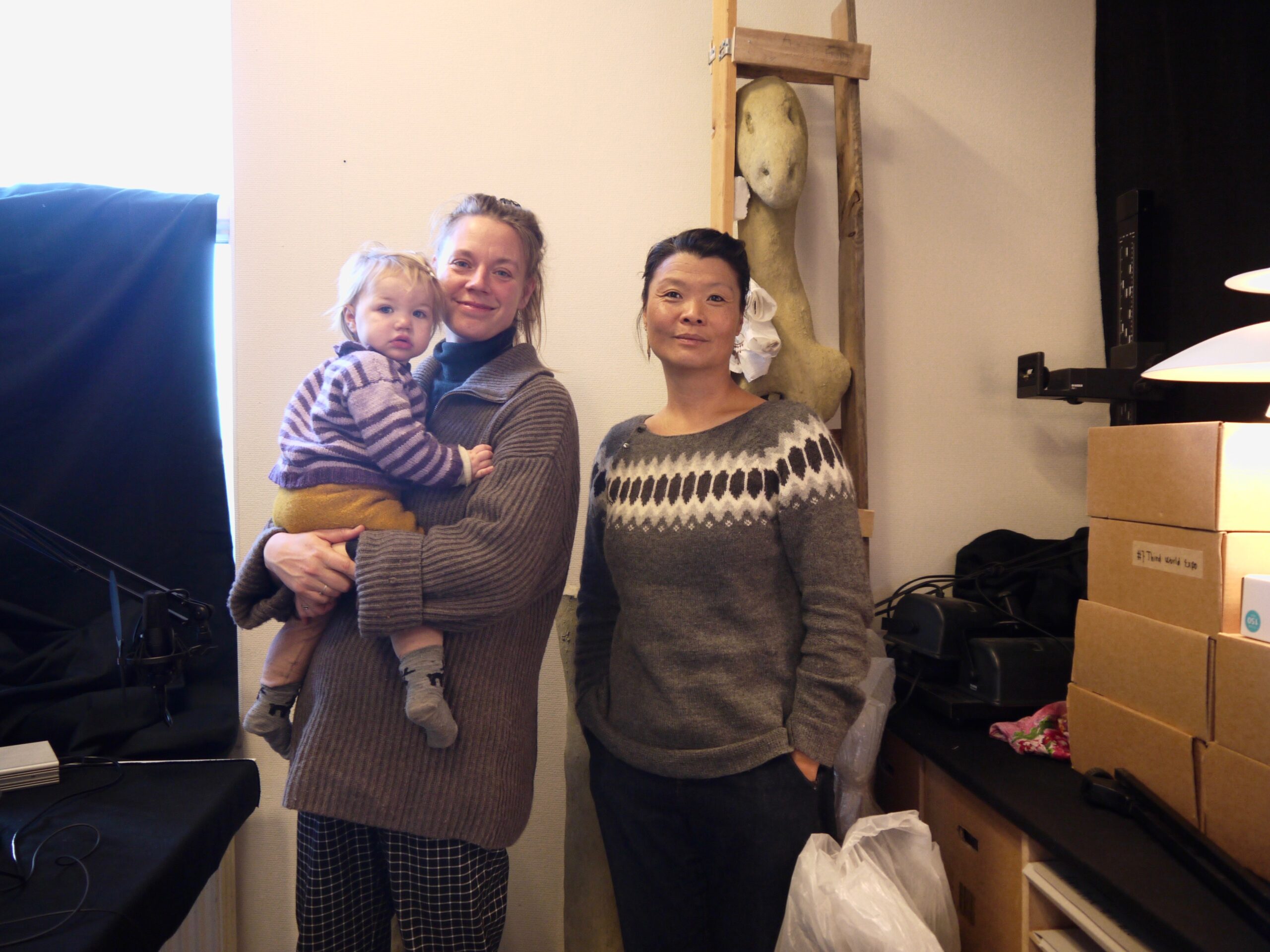Art4Med: Reappropriating personal history through writing in Copenhagen
Published 23 December 2021 by Elsa Ferreira
At the Center for Art and Mental Health in Copenhagen, Ida Bencke, Birgit Bundesen and Nazila Kivi organized writing workshops and an exhibition around the theme of maternity. This initiative was supported by the Art4Med program, in which art contributes to medicine—in this case, serving as a tool to express trauma. Makery reported on their last session of 2021.
November 19 marked the last of four sessions at Copenhagen University Hospital’s Center for Art and Mental Health. For the past two months, Nazila Kivi has been giving workshops around the theme of maternity for marginalized audiences, such as LGBTQ or ethnic minorities. It’s all familiar territory for this Iranian artist and faculty member who works on the themes of public health, gender and ethnic heritage, at the intersections of art, activism and academia. “I’ve worked a lot on bodies, standards, reproduction, racialization,” she says.

Recognizing ethnic pain
The workshop was held over four sessions from October 22 to November 19, diligently attended by three women (only one was not able to be present for this last session). All of the participants were young mothers in their thirties and forties, from different backgrounds—one was adopted, another one’s parents were immigrants, the third one was born to a mixed-race couple—but they all had one thing in common: a traumatic experience of giving birth.
One of the women, Trine, had to have an emergency cesarean section. She suffered post-partum depression, she tells us, and is still bitter and angry about the experience. “Telling my story again is part of the healing process,” she says.
Uzma also had an emergency cesarean section. She believes that her hospital stay during the delivery did not go as it should have. “I have a strong feeling of negligence. I have given a lot of thought to what worked and what should have been done differently. We tend to trust the system, but I was not guided, nobody explained to me what was happening.” She also sees writing as a tool to put her emotions in order.
For Nazila Kivi, the experiences of these young mothers are a form of what she calls “ethnic pain”. “It’s not an official diagnosis, and the phenomenon is rarely documented—apart from myself, only one doctor was interested,” she says. “It’s a term that refers to the pre-supposition that a pain is not real, that it’s dramatized, exaggerated. It’s a doubt, a feeling, the sensation that you are treated differently.” This cognitive bias is related to the patient’s ethnic origins, and leads health professionals to doubt what the patients are saying, and even deny or postpone treatment.
“In Denmark, we barely talk about these subjects,” says Ida Bencke, co-curator of the Art4Med program and founder of the Laboratory for Aesthetics and Ecology, an independently curated collective. “We have an immigration policy that puts non-ethnic Danish families under pressure and relies on many stereotypes.”
In 2018, the Danish government passed the “ghetto package” law to delineate certain zones according to the percentage of immigrants. “For families that live in the so-called ‘ghetto’, sending their kids to nurseries and kindergarten to ‘learn Danish values and culture’ is mandatory,” Bencke says. “The free choice of whether and when to institutionalize your children is taken away from you when you inhabit these marginalized zones.” Danish families living in the rest of the country can decide whether or not their children go to school up to the age of 6 years old.

Playfulness as a way to manage crises
Kivi’s workshop is a pilot, on a theme that has yet to be explored further at the Center for Art and Mental Health. But within this unit situated in the psychiatric ward of the university hospital, writing is a therapeutic tool to be fully studied in detail.
So the psychiatrists of the Center for Art and Mental Health developed a method deployed over 15 weeks. The objective is to create a safe environment where the patients feel free to explore. The inspiration for this approach was British psychoanalyst Donald Winnicott’s concept of the “good enough parent”, according to Birgit Bundesen, chief psychiatrist and the Center’s director.
“Winnicott observed thousands of children and their interactions with their mothers in order to identify what it takes for a baby to develop a healthy mind,” she says. “He found that in order for babies to feel free enough to play on their own, they must have a good enough caretaker in the next room. The primary parent is not the perfect parent, but the one who is good enough to create a safe environment.”
In the writing group sessions, it’s the same thing: “We want to establish a positive workshop. Art is not not-dangerous, it triggers things in patients. In order to contain this creative process, we need a holding environment.”
“This is not therapy throught art, it’s ‘participative art’,” Bundesen explains. “Participation and work on esthetics are techniques used to restructure conceptual, mental and physical faculties. Art is a tool to desynchronize and reorganize the patients’ mental material.”
From this perspective, “playfulness is the active ingredient. If you are able to mobilize a playful mode in the mind, then you are able to handle mental crisis in a different way, because it’s a way of keeping your mind fit.”
The instructions have been developed to address different mental abilities: take a new perspective on a given situation, address others (for example by writing letters to significant others), have a more positive vision of yourself, write about other memories besides trauma, etc.

Experiencing eye vs. eye of the text
The workshop proceeds in three stages.
– First is the beginning. “It’s a stage where there is a lot of anxiety. You don’t know each other yet, there is excitement, a lot of fantasies about what is going to happen.” The first session consists of establishing this safe environment in which the patients will feel comfortable to play in.
For Nazila, this means “being honest about your own position. The participants know what’s at stake, that my interest is personal—some of my work is based on my personal experience—but that there is also a research objective.” The artist makes clear the fact that this is not a group therapy, but an artistic workshop.
– Next is the time to be daring. “This is when the group can move on to more daring exercises, such as mentalization,” says Bundesen. “Take for example the description of a situation involving at least two people. Most people will choose a situation of conflict—fighting at home, being bullied at school—and write about it from an autobiographical perspective. The next stage would be to write the same scene from the point of view of the other person present. The group also works on inner dialogues or transformative processes.”
Regardless of the material, the method is the same: “We distinguish between the eye of the experience and the eye of the text. We discuss texts as esthetic material. It’s what we call the esthetic distance of art: there is a temporal and spatial, but also esthetic distance.”
This same distance allows participants to exchange about heavy and highly personal subjects. “One patient wrote a fable about a woman who was raped by a bear,” Bundesen recalls. “When she read her text aloud, it was clear that she had autobiographical material invested in it. We talked about the fable as a genre, how to create horror effects in a text, metaphors… Six months later, during an interview, she told me that she had been raped when she was 15 years old by an older man. She never told anyone, because she feared the mercy of others. Through writing, she was able to share something painful while taking ownership of it—she wasn’t the victim, she didn’t need to take other people’s good advice. It was about the eye of the text.”
Meanwhile, Nazila Kivi works using the method of collective memory. “There are a few rules: you must write in the present tense, according to your own perspective and without rationalizing or explaining, only from an emotional point of view.” Then the author reads her text slowly, so that the other members of the group can help to analyze it.
– Finally, closure. “This problem is not sufficiently taken into account in art and culture interventions involving people with mental health issues,” says Bundesen. Indeed, the group has a tendency to not want the sessions to end, something that the workshop leader must consider from the very beginning by always reminding participants of the finite nature of the sessions and their duration.
In Kivi’s workshop, the participants are already searching for a way to continue beyond this last session. In order to conclude this process, the three organizers hope to formalize the workshops in a book that would include all the texts written by the participants during the workshop: poems, fictions, a manifesto on consent… “It’s a way for closure, but also a way of opening this conversation to the world,” Bundesen hopes.
Restoring “hospitality” in hospitals
If these workshops are held in a reassuring and private environment, Birgit Bundesen and Ida Bencke would also like to open up hospitals to the world. As Bundesen points out, the Latin etymology of the word hospital refers to host or hospice, as a form of hospitality toward oustiders. And the former term for psychiatrist was alienist.
In addition to the workshops, the Center for Art and Mental Health hosted an exhibition open to the public curated by Ida Bencke. Titled m/others, it was awarded “exhibition of the year” by the Danish newspaper Information and explored experiences of maternity, infrastructures and institutions in charge of future parents.
“Most of us have hospital memories from very intense periods of our lives,” says Bencke. “It’s the emotional baggage that people came to the exhibition with and that we tried to work with.”
For the two curators, the exhibition is a non-invasive event that is as meaningful to both people living inside the house as to the general art crowd. “The challenge is to find a way to navigate between preserving safe spaces for residents while opening up to the outside,” says Bencke. “For now, I’m not sure that we’ve succeeded 100%.”
Some doctors were not consulted about the exhibition beforehand and were quite annoyed by it, especially one doctor who was upset by a sound installation that was just above the senior consultant office.
“We need more time to build trust within the house,” says Bencke. “We also need to jump out of the capitalist agenda to produce nonstop and run very fast all the time, because things get done halfway,” adds Budensen.
This ambitious vision seems to be quite within reach of the two women, as Bencke has just been commissioned by the Center for Art and Mental Health to continue working with Bundesen to implement this program initiated in the context of Art4Med. An opportunity to create new relationships… and to rethink old ones.
More about “m/ other” at the Laboratory for Aesthetics and Ecology
ART4MED consortium is coordinated by Art2M / Makery (Fr) in cooperation with Bioart Society (Fi), Kersnikova (Si), Laboratory for Aesthetics and Ecology (Dk), Waag Society (Nl), and co-funded by the Creative Europe program of the European Union.
